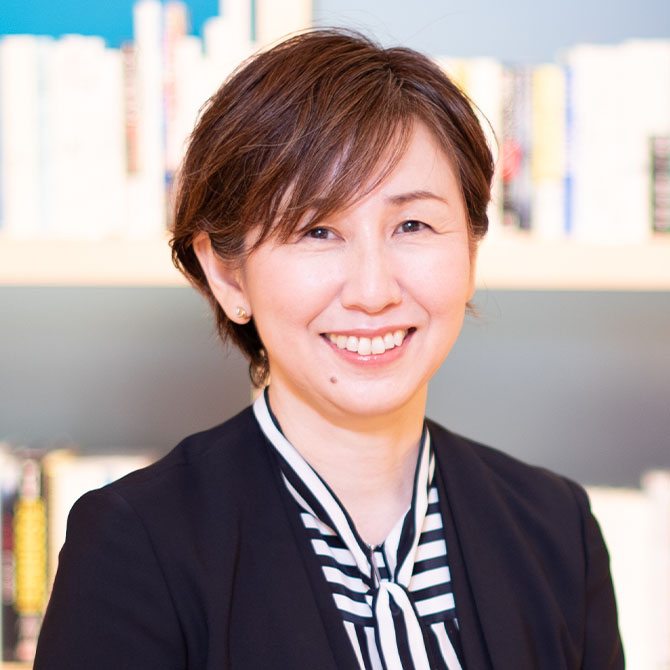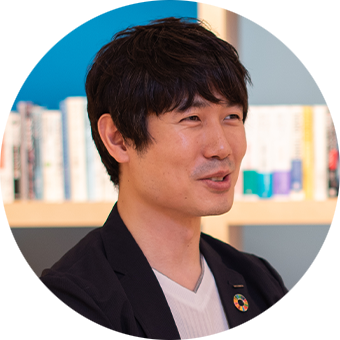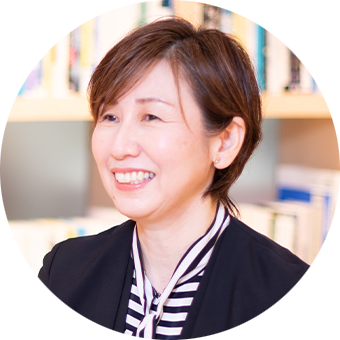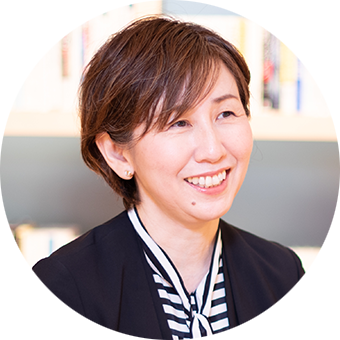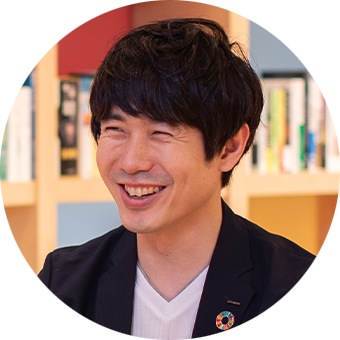Achieving Wellbeing with Health Data
New Services Born from Open Innovation
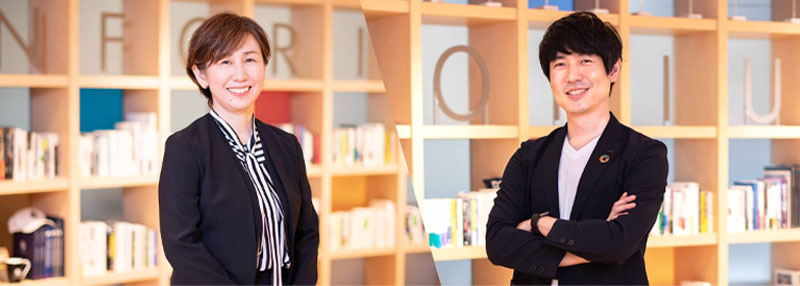
Open innovation (OI), which creates new value through co-creation with startups and other companies, has been attracting attention not only in Japan but also around the world for some time now. However, it is said that the rate at which OI leads to the launch of actual services is not high.
Under such circumstances, in October 2022, NTT DATA launched a "wellbeing measurement app" born from OI. It features the ability to easily estimate "the degree of wellbeing* in the current environment" from facial complexion captured with a smartphone camera.
What is the path leading to the launch of an actual service from OI, which is not an easy thing to do in reality, and what is the future that will unfold through the use of OI? Two people at the forefront of the field shared their thoughts.
*The degree to which the person is "physically, mentally, and socially vibrant," rather than whether or not he or she is sick
Fumie Minato
Fumie has a wealth of experience in new business planning focused on the medical and healthcare fields, as well as investment and growth support for global digital offerings. Currently, she has been engaged in "creating consumer-driven businesses by integrating healthcare data with data from various industries and companies" using cloud-based health management solutions.
Izuru Watanabe
Izuru joined NTT DATA in 2004 and leads the development of new services utilizing advanced technologies such as distributed computing, metadata content distribution, and robotics. He also focuses on agile development and service design.
Expanding from Employee Health Management to New Value Areas
Watanabe: We are seeing new services emerging one after another, and many of the markets in the world are changing rapidly.
Companies cannot grow without developing new businesses, and collaboration with startups, or OI, has attracted attention for about 15 years in order to create value quickly.
NTT DATA launched the "From the Port of Toyosu" initiative in 2013 to actively pursue OI, and has continued to seek collaboration with startups around the world. The goal is to jointly create new businesses that are triple win-win for the three parties: companies that are creating businesses from new perspectives and start-ups in Japan and abroad with new technologies; our customer companies that are developing their existing businesses; and NTT DATA.
Ms. Minato, please tell us about the "Health Data Bank" that you are working on and the new "wellbeing measurement app" that was born out of OI.
Minato: NTT DATA has been providing "Health Data Bank" as a cloud-based service to support corporate employee health management since 2002. Currently, more than 3,000 companies (organizations) and 4 million people are using this service, which holds more than 70% of the cloud-based service market in this area. On behalf of companies, NTT DATA receives the results of their employees' health examinations (medical checkups) from medical checkup organizations, converts and standardizes the data format, which varies among medical checkup organizations, and registers the results in a database. This data is then used by human resources personnel and industrial physicians at the companies to manage the health of their employees.
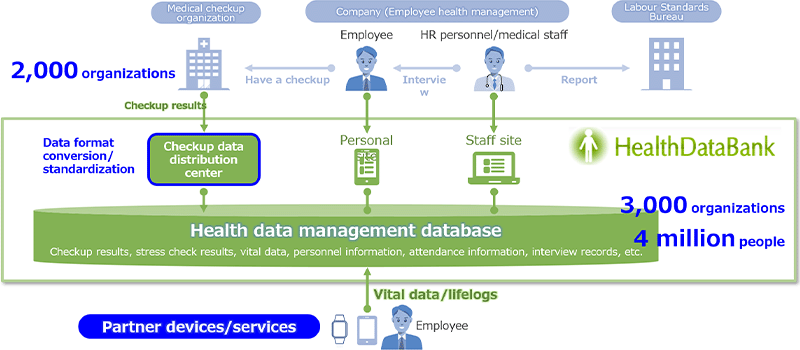
Fig.: What is Health Data Bank?
Watanabe: What was born from OI this time is one of the services in this "Health Data Bank," the "wellbeing measurement app," isn't it? The "wellbeing measurement app" acquires more detailed data than a medical checkup, doesn't it? Why is this necessary?
Minato: Since the novel coronavirus pandemic, the number of people working remotely has increased, and employees have fewer opportunities to see each other at work. Even if an individual is having a problem, it has become more difficult than before for supervisors and others to detect it. Therefore, there is an increasing need to utilize digital technology to detect even subtle signs of individual problems and disorders – signs that would not be detected even through real communication in person.
In addition, technological advances have made it possible for individuals to easily measure their vital data and lifelog using familiar devices such as smartwatches, and companies, for example, are positioning vital data and lifelogs as "behavioral data indicating personal health characteristics and preferences" and utilizing them in promotions and product development tailored to customers' health conditions, which indicates growing expectations for the use of health data for business purposes.
Until now, the main source of health data has been the annual health checkups conducted by insurers and employers based on the regulations, and from the private sector's perspective, obtaining and utilizing this data has been a bit of a hurdle. However, now that daily vital data and other data can be obtained in a way that is integrated into the daily lives of individuals, I believe that the use of health data will expand rapidly. Due to the fact that the super-aging society has become a reality, the government has been promoting the "realization of a society of health and longevity" and encouraging "each individual to take responsibility for his or her own health." In addition, the novel coronavirus pandemic has caused many people to feel firsthand a threat to their lives, and they are beginning to realize the "importance of their health." In response to these circumstances, I believe that it will become commonplace for each and every individual to measure their own vital data on a daily basis to check for any problems or disorders, and to utilize this data to achieve wellbeing.
To help realize such a society, NTT DATA has been providing the Health Data Bank as a "backyard mechanism for collecting and managing health data" for several years to companies and organizations in various industries, including insurance, manufacturing, medical, retail, and smart cities, that are working on the utilization of health data, and in order to provide new value, we have started the "wellbeing measurement app."
Overcoming Challenges by Combining the Strengths of Both Companies
Watanabe: Vital data is sensitive personal information, and it is essential to have the technology and trust that enable a safe and secure system. On the other hand, the technology to collect vital data is evolving.
So, you have utilized OI to develop new services in line with the speed of evolution in the world.
Minato: The technology for collecting vital data is a "dynamic" market where not only devices are evolving, but also services are increasing at an astonishing pace. NTT DATA cannot easily keep up with this dynamic market if it tries to do everything on its own. Therefore, in order to increase our speed and expand our business, we decided to use OI or collaboration with other companies, including start-ups, for the "dynamic" part. The OI team led by you, Mr. Watanabe, listened to our needs and quickly connected us with the most suitable companies, so we were able to use the technology of NuraLogix, a Canadian company with an established reputation for "technology that analyzes facial video information taken with ordinary smartphone cameras to estimate vital data and other information." This is how we were able to launch the "wellbeing measurement app" and venture into this new field.
Watanabe: We, the OI team, understand the needs of business divisions within the company and search daily for startup companies that have strengths that match those needs. This time, I think we were able to quickly find a match that met the needs of Ms. Minato's team, but nevertheless, it took more than a year to release the service. I guess you had to overcome many obstacles before the release of the service?
Minato: Since the utilization of health data is in its infancy, related legislation has lagged behind, and guidelines issued by the Ministry of Health, Labour, and Welfare (MHLW) are being updated as needed. In the development of the "wellbeing measurement app," the specifications had to be modified several times in order to comply with the relevant guidelines, etc.
It was due to the 2014 legal revision that the programs that could potentially affect the life and health of users were subject to regulation, but as a result of a close examination of the guidelines issued by the MHLW at the end of March 2021, it became necessary to change the specifications, and we postponed the launch of the service, which had been scheduled for July 2021. Incidentally, "medical device applicability of programs" is a new topic, and in the absence of precedent, the MHLW and others cannot help but make decisions one by one on the medical device applicability for programs that appear on the market on a daily basis. Due to such circumstances, there are perspectives that are not fully expressed in the guidelines, and perspectives that are difficult to decipher to determine the correct answers. We consulted with various experts as we carefully revised the app, but new perspectives that needed to be addressed arose one after another, and as a result, we were finally able to offer the app from October 2022, much later than originally planned.
Watanabe: So, you are saying that data utilization for services, which is still in its infancy, requires deciphering guidelines and coordinating with all related parties one by one. I guess this is where you were able to take advantage of NTT DATA's ability to develop in accordance with national guidelines, its accumulated know-how in the medical industry, and its stamina to deal with frequent changes in the development schedule.
By the way, how many items can be measured with this app?
Minato: NuraLogix's technology can measure more than 20 items, and more will be added in the future. On the other hand, in Japan, in accordance with the MHLW guidelines, health devices that are not medical devices are strictly limited in terms of the items they are allowed to measure in order to prevent individuals from accidentally using them to harm their lives and health. The "wellbeing measurement app" is a health device and cannot handle items that are allowed only for medical devices, such as blood pressure. Since the guidelines do not provide comprehensive information on items that should not be handled by health devices or on use cases, we had to make persistent efforts to obtain opinions from experts and to confirm with the MHLW. As a result, we defined the app we are providing this time as "an app (not a medical device) that uses cutting-edge technology to estimate the ‘degree of wellbeing in the current environment’ from facial complexion captured by a smartphone camera, etc.," limited its use to "‘improvement of workplace environment by employers, etc.’ and collection of materials for consideration for ‘customer attraction to products and confirmation of its effectiveness by companies, etc.,’" and decided to provide wellbeing indicators of four items, i.e., heart rate, respiration rate, stress signs, and facial skin age, as well as a comprehensive evaluation of the wellbeing indicators, etc. These measurement items are not "vital data" but are positioned as "indicator values to estimate the degree of wellbeing."
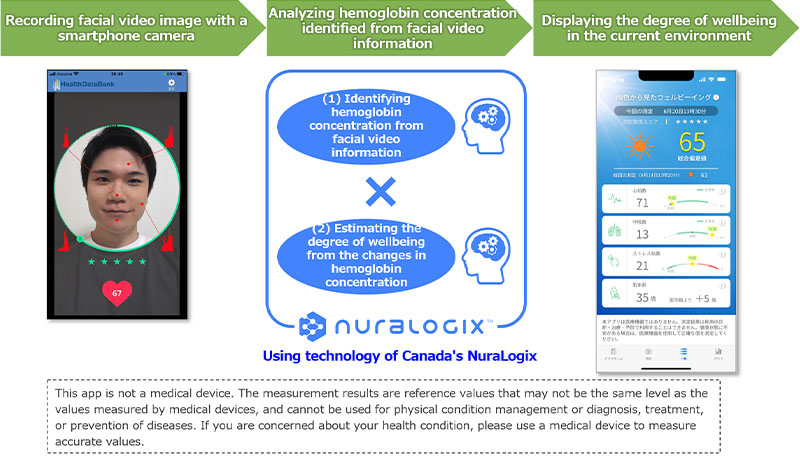
Fig. : What is the wellbeing measurement app?
Although NuraLogix technology can measure data on more than 20 items, we are starting with four items because NTT DATA considers the safety and security of services related to the lives and health of individuals to be of great importance. In the future, we will review the measurement items as needed in accordance with revisions to the guidelines.
Contributing to the Improvement of People's Wellbeing by Utilizing Health Data
Watanabe: We, the OI team, support the creation of new services by searching for promising startups and liaising between them and our internal departments. We have been involved in dozens of projects every year. However, actually creating new services and new values involves a series of hardships, as Ms. Minato mentioned. Among the projects I have been involved in, less than 10% have made it to the launch of a new service.
When introducing a new service to the market, it is necessary to be prepared in all aspects, including business, systems, and usability. Perhaps one of the distinctive styles of NTT DATA's OI is to make all the necessary preparations while focusing on speed. In this case as well, I think the release of the service was made possible by the fact that both NuraLogix and our company were able to promote the project tenaciously, taking advantage of each other's strengths, to achieve the goal of delivering to users a valuable service based on the latest technology while meeting the guidelines in Japan. In most cases, we are faced with challenges that we did not initially anticipate, but it is important to combine the wisdom of both companies and work together to overcome them.
For this project, we had to comply with strict regulations because the service was to be provided domestically, but conversely, wouldn't it be able to offer more measurement items in other countries?
Minato: Currently, our group company in Brazil is preparing a POC to verify the usefulness of the "wellbeing measurement app." Since regulations differ by region, we believe that we can make the maximum use of NuraLogix's technology to measure many items including blood pressure in the POC in Brazil. The healthcare area is strongly affected by regulations in each region, which makes it difficult to create a global business, but this "wellbeing measurement app" is a service that is not bound by regional boundaries. We have developed a service in Japan using technology from outside of Japan, and are now expanding the service outside of Japan. Using the POC in Brazil as a foothold, we intend to realize global expansion in cooperation with group companies in other regions.
Watanabe: Can you tell us about the future prospects in Japan?
Minato: We believe there will be many business opportunities for the "wellbeing measurement app."
NuraLogix's technology, which does not require a dedicated device and can easily collect data using "commonly used smartphone cameras," is very attractive to companies that are working on utilizing health data of a broad range of individuals. As it took NTT DATA two years to launch the service, it is expected to take some time for other companies to catch up, so we plan to aggressively develop the market with our competitive service. NTT DATA is proud of its considerable know-how and experience in handling health data through the 20 years of operation of the Health Data Bank, and through this project, we have had the opportunity to learn more deeply than ever before about the latest legal systems, guidelines, and other issues related to the utilization of health data. As interest in the use of health data in the private sector grows rapidly, it is essential to have expertise in handling health data, and we believe that NTT DATA can contribute in this regard as well.
Our mission is to work with various companies to contribute to the improvement of people's wellbeing by integrating a system for collecting their health data without stress and combining it with a variety of data, in their daily lives.
To this end, we will continue to utilize OI to combine our strengths with those of other companies and create new value.
Watanabe: NTT DATA is working to realize a sustainable society. One of the pillars of this initiative is "Achieving a society where everyone can live healthy and happy lives," which is exemplified in what Ms. Minato has just described today.
The initiative has another pillar, which is "Companies achieving growth in ways that support a sustainable society," for which we believe co-creation is essential. I am convinced that OI activities, in which companies collaborate with each other to create new markets, will help move society in a better direction. We will continue to vigorously promote the "From the Port of Toyosu" initiative to create new value without borders.
